Maryland Lawn Pest Control: How to Identify & Kill Lawn Insects
You want a nice, green, thick lawn. Who doesn’t?
Unfortunately, lawn insects can get in the way of your plans. They can make your lawn look less than stellar with brown spots, dull color, or even bare areas. And since all of these symptoms can point to other problems, you might actually not even know bugs are the issue.
Let’s look at some common lawn insects in Maryland and how you can eliminate them and keep them out of your grass so your property can shine.
Table of Contents
- How To Identify And Get Rid Of Lawn Pests In Maryland
- Lawn Grubs
- Chinch Bugs
- Armyworms
- Sod Webworms
- Cutworms
- Cranefly Larvae
- DIY Lawn Pest Control Vs. Hiring A Professional
- How Much Does Lawn Pest Control Cost?
- How to Choose Lawn Pest Control Services in Central and Southern Maryland
How To Identify And Get Rid Of Lawn Pests In Maryland
When you sense that your lawn isn’t happy, you may suspect lawn insects. But how do you know which bugs are plaguing your grass and how to get rid of them?
Use This Tool to Compare Your Local Lawn Care Companies
In this guide, we talk about how to identify lawn insects, common signs of damage, and how to get rid of these pests so you can have a great lawn in Maryland.
Lawn Grubs
Grubs in your lawn can be pretty sly. It’s because they work underground, so you may not even see them out right.
In fact, they can attack your lawn and you don’t even know they’re there. Before you realize it, your lawn isn’t doing so well and you’re wondering what went wrong.
Here are the basic facts about grubs in Maryland grasses.
How To Identify Lawn Grubs
So you might have seen an adult grub and not have even realized it. If you’ve seen a Japanese beetle on your rose bushes, for instance, you’ve seen an adult grub.
Lawn grubs are technically the larvae of some insects, such as Japanese Beetles, European Chafers, Southern Masked Chafers, and June Beetles.
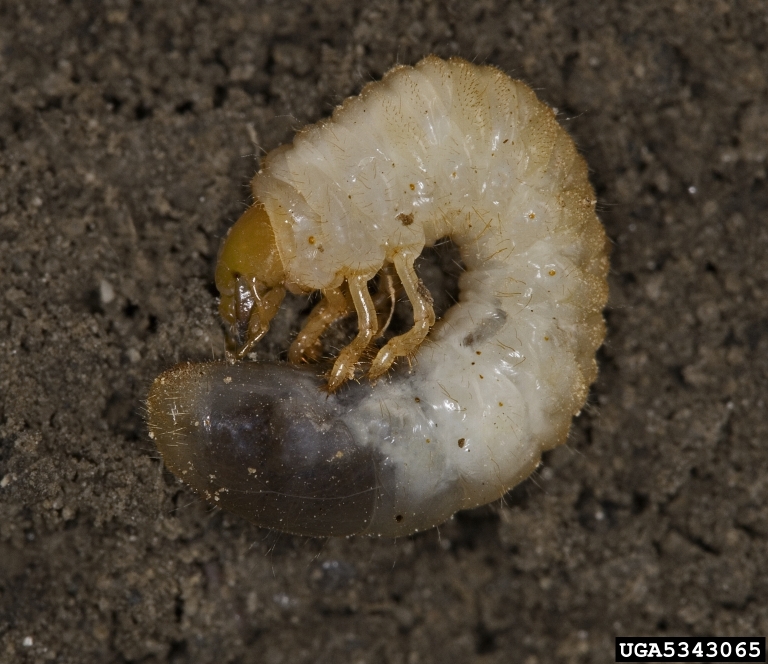 These larvae have C-shaped, white, soft bodies with legs right beneath their brown-ish heads.
These larvae have C-shaped, white, soft bodies with legs right beneath their brown-ish heads.
If you or your lawn care professional suspect a grub infestation, you can sometimes dig up a few small spots in your yard that seem impacted and find these nasty larvae. Other critters, like raccoons and skunks can also be found tearing up a lawn that has grubs since they are treats for these animals.
Signs Of Grub Damage
Since you can’t always see grubs diligently destroying your lawn underground, you want to know the common signs of grubs in your lawn to ensure you catch them before they do too much damage.
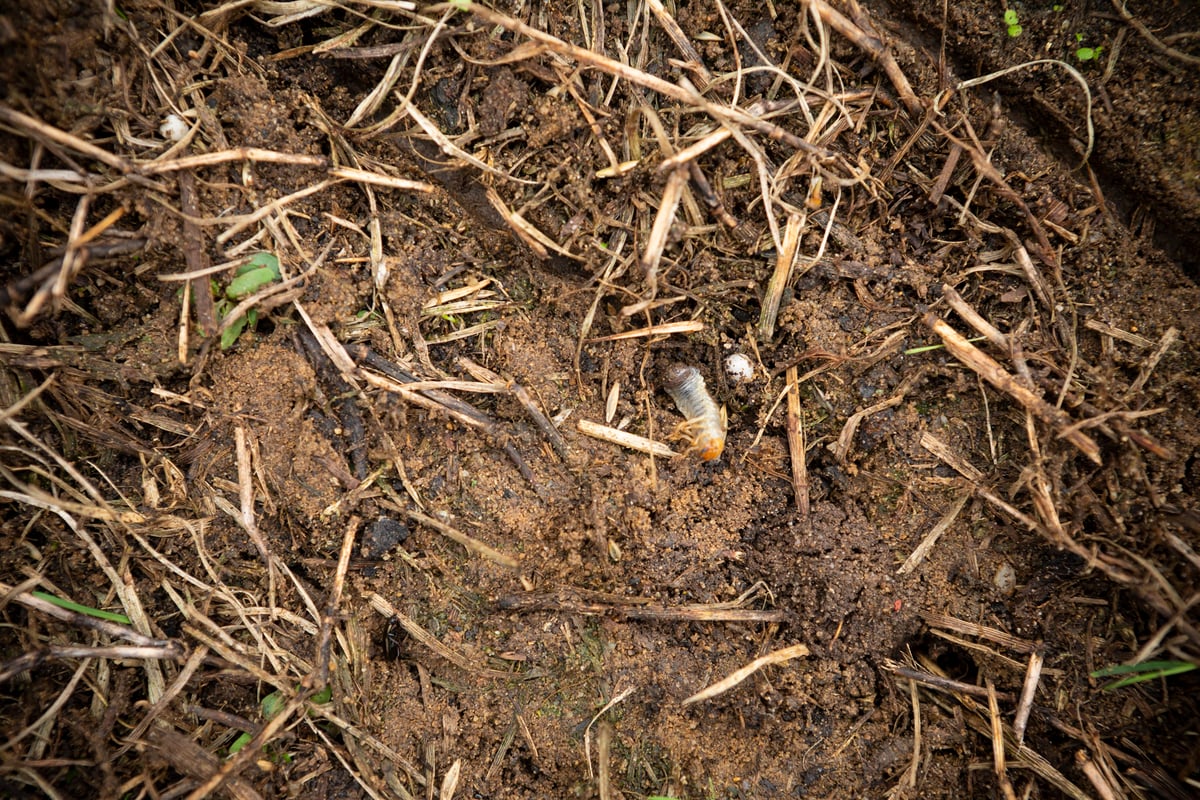 The first symptoms of grub feeding you might notice in your grass are patchy areas of discolored, stressed, or wilting grass. These areas of your lawn may seem like they are suffering from drought, but they don’t respond to watering or irrigation. The areas that look impacted may be irregularly shaped and feel spongy, and if you grab them you might notice they roll right up off the soil as if their roots aren’t even attached to the ground.
The first symptoms of grub feeding you might notice in your grass are patchy areas of discolored, stressed, or wilting grass. These areas of your lawn may seem like they are suffering from drought, but they don’t respond to watering or irrigation. The areas that look impacted may be irregularly shaped and feel spongy, and if you grab them you might notice they roll right up off the soil as if their roots aren’t even attached to the ground.
You may not see symptoms in spring when your grass is vigorously growing. The larvae emerge as flying beetles in summer, feeding on plants above ground and then depositing eggs in lawns again. But it’s likely that you’ll spot the damage once those new grubs hatch and feed on your grass roots that are now weakened by summer’s heat and drought.
How To Get Rid Of Grubs In Your Lawn
The trick to banishing grubs from your grass is catching them when they are young.  Targeting a grub treatment on your lawn by a professional lawn care technician in May and June is the best strategy for preventing severe damage.
Targeting a grub treatment on your lawn by a professional lawn care technician in May and June is the best strategy for preventing severe damage.
Embracing a proactive lawn care program that includes fertilization and weed control can also keep your lawn healthy and help it better withstand lawn grubs.
Chinch Bugs
Pests like chinch bugs in your lawn may be small, but they can do quite a bit of damage to your grass. They basically suck the blades of grass clean with their piercing mouthparts and then inject them with their saliva, clogging the vascular tissues of your lawn and blocking access to water. As a result, your grass tends to suffer and die.
Let’s learn more about these pests and proper chinch bug treatment techniques so you can better battle these insects.
How To Identify Chinch Bugs
Adult chinch bugs in your lawn are pretty small – approximately one-sixth of an inch long – and they have white, shiny wings.
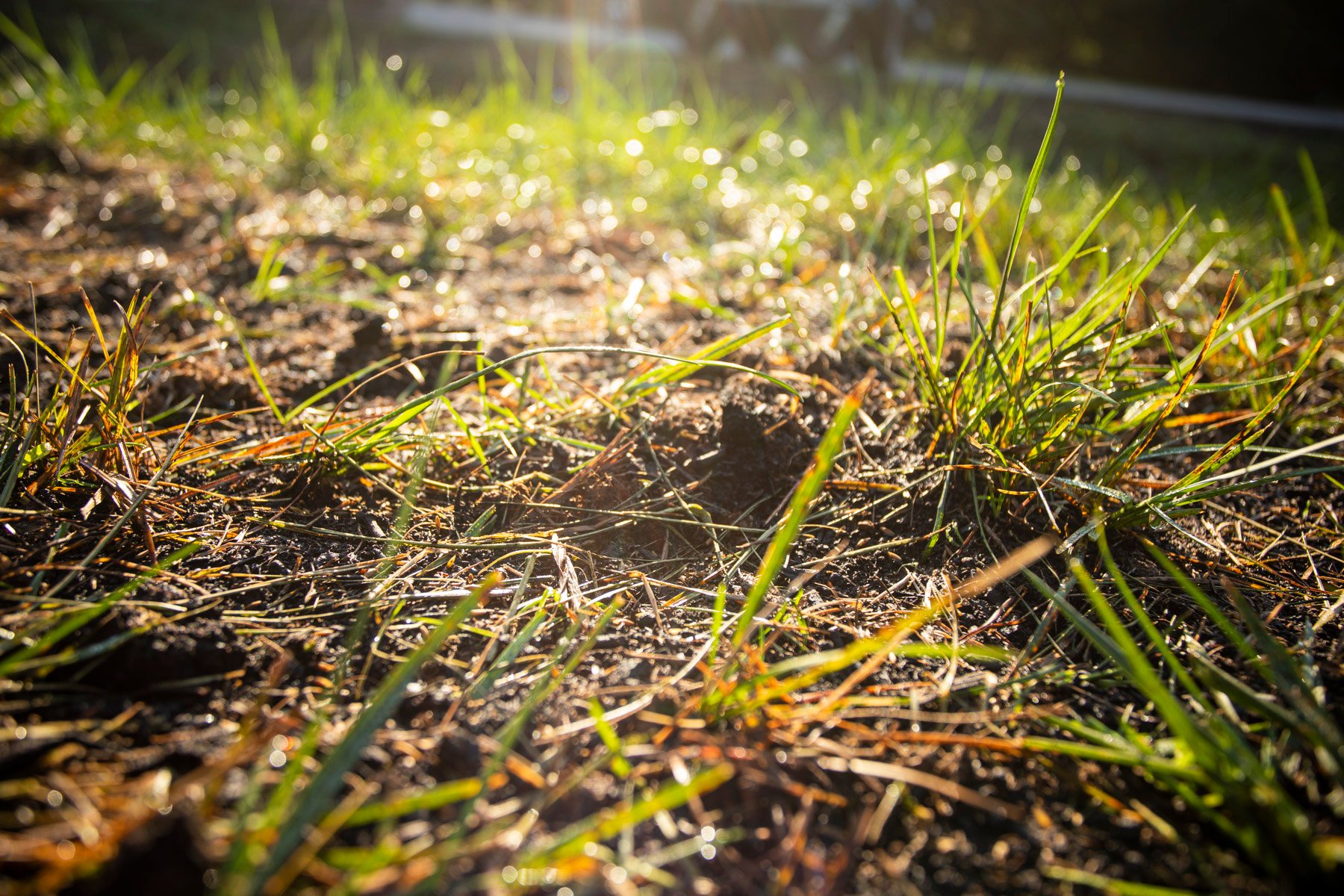 Since they are so miniscule in size, you may never notice them.
Since they are so miniscule in size, you may never notice them.
Both chinch bug nymphs and adults feed on Maryland lawns. Adults overwinter in thatch or tall grasses to try and stay protected before reemerging in spring to lay their eggs. Within two weeks, females lay up to 170 eggs each on the ground near the base of grass blades or in the blades themselves.
Signs Of Chinch Bug Damage
Chinch bugs in your lawn are so small and fast-moving, so you may not physically see them.
What you may see is the damage they cause. They use their piercing mouths to suck sap from grass blades, giving it a drought-like or stressed appearance. They are most active in July and August. You can find them mostly in Maryland lawns with thick thatch and compaction.
When you first notice small yellowing spots in your lawn, you may assume other issues before realizing it’s chinch bugs, including drought, nutrient deficiencies, or turf disease. As you’re trying to solve those other problems, the chinch bugs may continue harming your lawn.
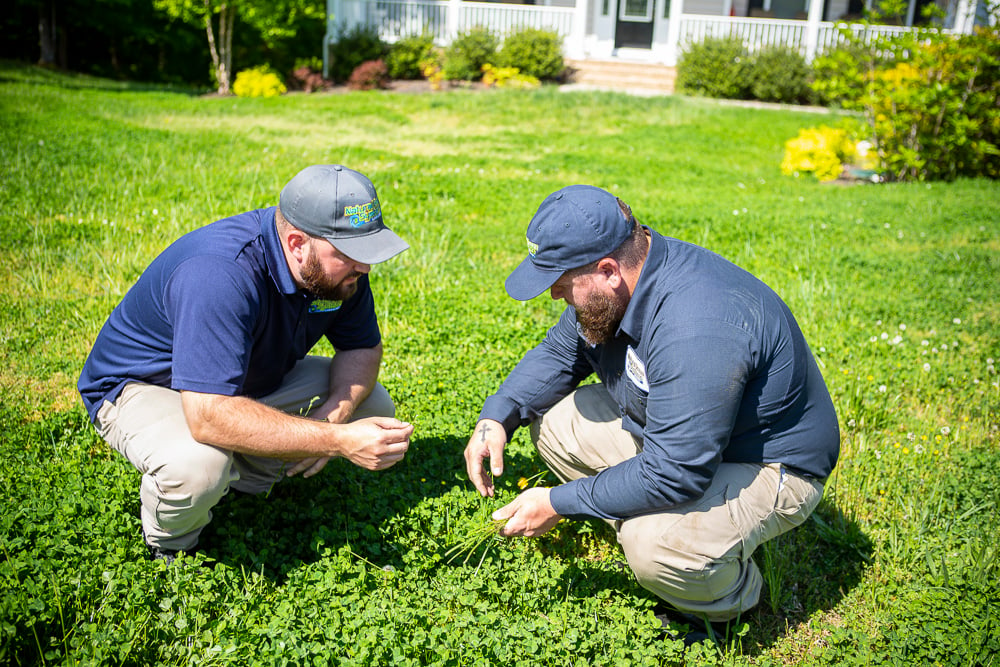 If you suspect chinch bugs but can’t really see anything, you can try a test with an open-ended coffee can. Stick it about 2 inches into the soil on the fringe of a patch of damaged grass. Fill it with water, looking for adults as they float to the surface. Add more water as it filters into the soil. In 5 to 10 minutes, you should be able to see some of the bugs. If you don’t have an open-ended coffee can, you can also try removing a core of grass and soil with a shovel and submerging it into a bucket full of water, looking for insects to rise to the top. You may see some nymphs that are orange or red and then adults that are darker with whitish wings.
If you suspect chinch bugs but can’t really see anything, you can try a test with an open-ended coffee can. Stick it about 2 inches into the soil on the fringe of a patch of damaged grass. Fill it with water, looking for adults as they float to the surface. Add more water as it filters into the soil. In 5 to 10 minutes, you should be able to see some of the bugs. If you don’t have an open-ended coffee can, you can also try removing a core of grass and soil with a shovel and submerging it into a bucket full of water, looking for insects to rise to the top. You may see some nymphs that are orange or red and then adults that are darker with whitish wings.
You can also attempt to visually inspect the fringes of the damaged areas where the grass is still green. Pull back the lawn and look for movement of insects beneath the thatch. While chinch bugs can be pretty tough for the untrained eye to spot, it might be worth the effort if you suspect them in your lawn.
How To Get Rid Of Chinch Bugs
When it comes to how to get rid of chinch bugs in Maryland, a lawn care professional will use a curative insecticide application to fight infestations. The treatment will be most effective when the bugs are actively feeding.
Unfortunately, there is no preventive treatment for chinch bugs, but you can help prevent chinch bugs by removing the conditions they love – namely thatch.
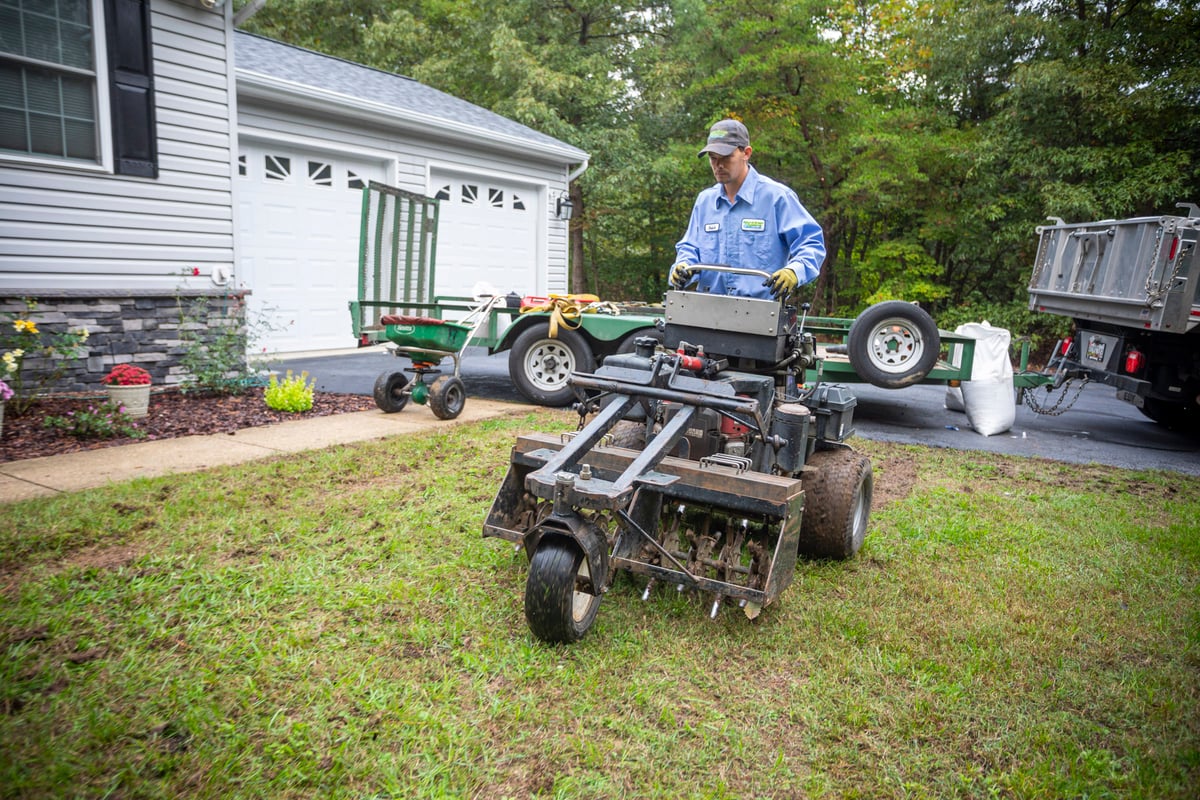 An annual aeration and overseeding service can reduce your thatch and compaction, thicken up your lawn, and improve the health of your soil, encouraging healthier grass. Aeration is the process of using an aerator to pull soil plugs from your lawn to encourage airflow and reduce compaction. Overseeding at this time maximizes seed to soil contact to ensure better germination.
An annual aeration and overseeding service can reduce your thatch and compaction, thicken up your lawn, and improve the health of your soil, encouraging healthier grass. Aeration is the process of using an aerator to pull soil plugs from your lawn to encourage airflow and reduce compaction. Overseeding at this time maximizes seed to soil contact to ensure better germination.
Other preventive methods include taking care of your lawn properly so chinch bugs aren’t drawn in. A stressed lawn attracts chinch bugs. Mow and water your lawn properly, as well as give it regular and precise fertilization treatments.
Armyworms
No one wants bugs chewing up their fine Maryland lawn, and armyworms can definitely use their army-like movement to march across your grass, leaving damage in their wake.
Here, we’ll share a bit more about armyworms in Maryland and how to get rid of armyworms, so you can stay more aware of these turf-invading troops.
How To Identify Armyworms
First, let’s answer the question, “What are armyworms?”
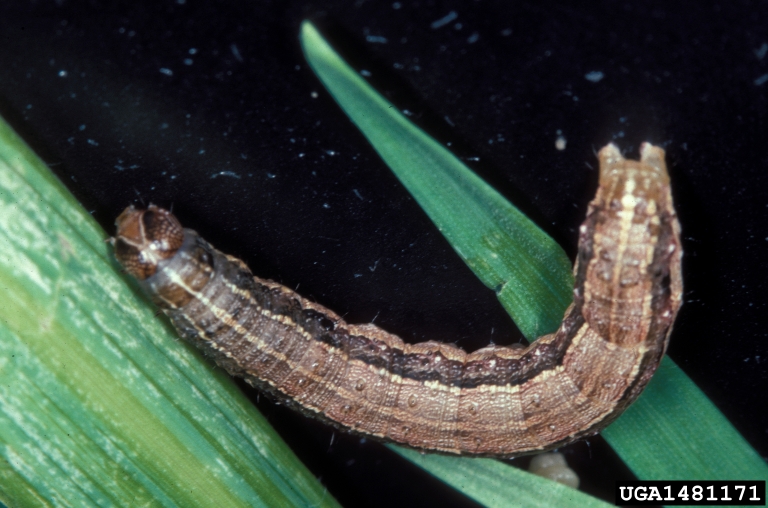 Armyworm larvae are 1 to 1.5 inches long and dark brownish-green or black with long white, orange, and brown stripes. The adult version of this pest is 1 inch long with a 1.5-inch wingspan, tan color and a small, white spot on each forewing.
Armyworm larvae are 1 to 1.5 inches long and dark brownish-green or black with long white, orange, and brown stripes. The adult version of this pest is 1 inch long with a 1.5-inch wingspan, tan color and a small, white spot on each forewing.
Signs Of Armyworm Damage
Armyworms in Maryland lay eggs on flat tree or shrub leaves. They show up in your grass by using air currents to move. Then they drop and settle in grass, laying egg masses.
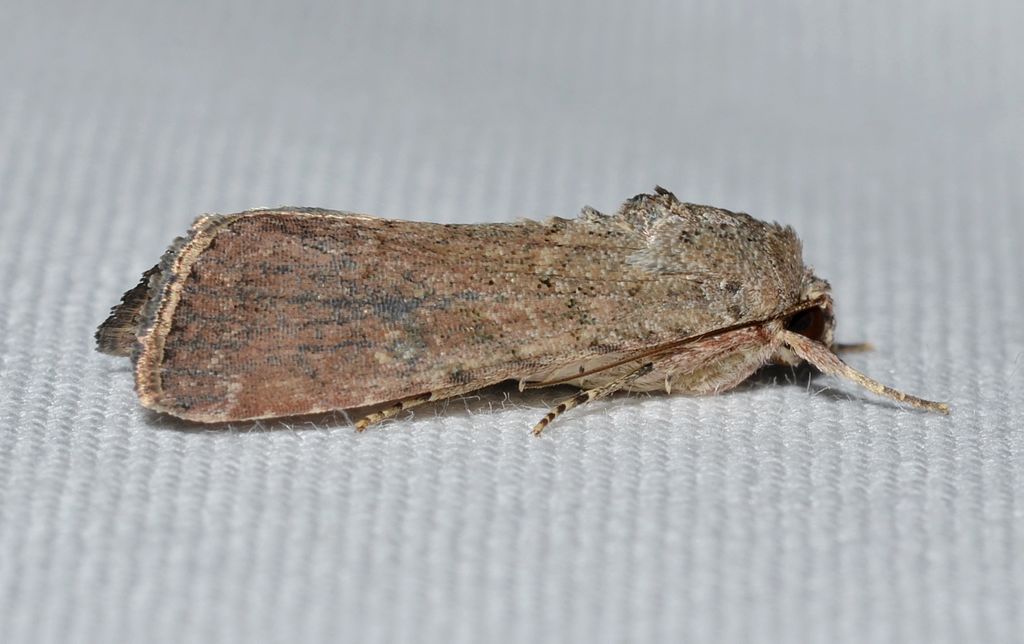 Once they hatch, armyworms feed on your grass, making it look drought-stressed. You can see the difference between drought and armyworm damage if you see ragged holes on your grass blades when you look closely.
Once they hatch, armyworms feed on your grass, making it look drought-stressed. You can see the difference between drought and armyworm damage if you see ragged holes on your grass blades when you look closely.
You might also notice armyworms’ sticky-looking egg masses that will be on plants or even buildings, patios, and outdoor furniture.
How To Get Rid Of Armyworms
What kills armyworms? You can control armyworms with an insecticide treatment.
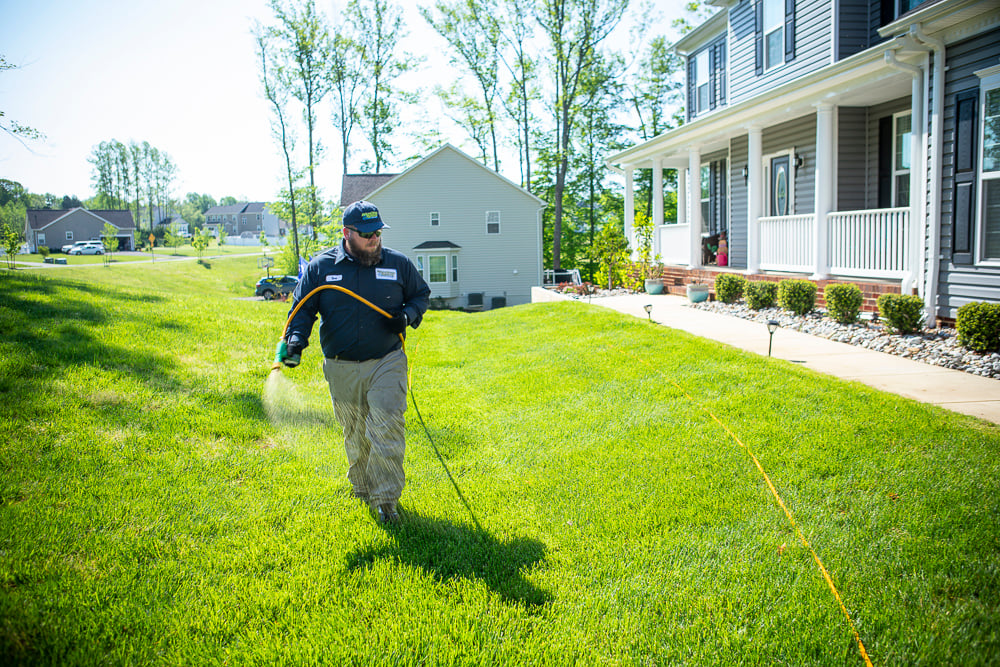 Since armyworms can have multiple generations per year, a lawn care professional might recommend a flea and tick control program that includes 4 to 6 applications between April and November that helps keep armyworms away.
Since armyworms can have multiple generations per year, a lawn care professional might recommend a flea and tick control program that includes 4 to 6 applications between April and November that helps keep armyworms away.
Sod Webworms
You might think by late summer, you don’t have much work left to do on your lawn.
Technically, that’s not the case. Some pests like sod webworms can strike in late summer and create some serious stress in your lawn’s life.
That’s why we’re here to help. Let’s look at sod webworm damage and common solutions and treatments for sod webworms in Maryland so you can discover an insect problem before it gets out of control.
How To Identify Sod Webworms
Adult sod webworms are tan-colored moths that are ½ to ¾ of an inch long. But they are pretty harmless. It’s their larvae you have to worry about. These grayish-tan caterpillars have small, dark spots on their bodies and brown heads. They can range from ¾ of an inch to 1 inch in size.
 Adult sod webworms scatter their eggs in the grass in the evenings when flying just above the turf surface in mid-June. Eggs hatch in approximately 10 days, and the larvae begin feeding on your lawn stems and roots until mid to late summer. They tend to feed at night and then hide during daylight hours in burrows lined with silk webbing.
Adult sod webworms scatter their eggs in the grass in the evenings when flying just above the turf surface in mid-June. Eggs hatch in approximately 10 days, and the larvae begin feeding on your lawn stems and roots until mid to late summer. They tend to feed at night and then hide during daylight hours in burrows lined with silk webbing.
Signs Of Sod Webworm Damage
The first signs of a sod webworm infestation are small, ragged brown spots in the turf. Upon closer inspection, these areas will have a grazed or scalped appearance.
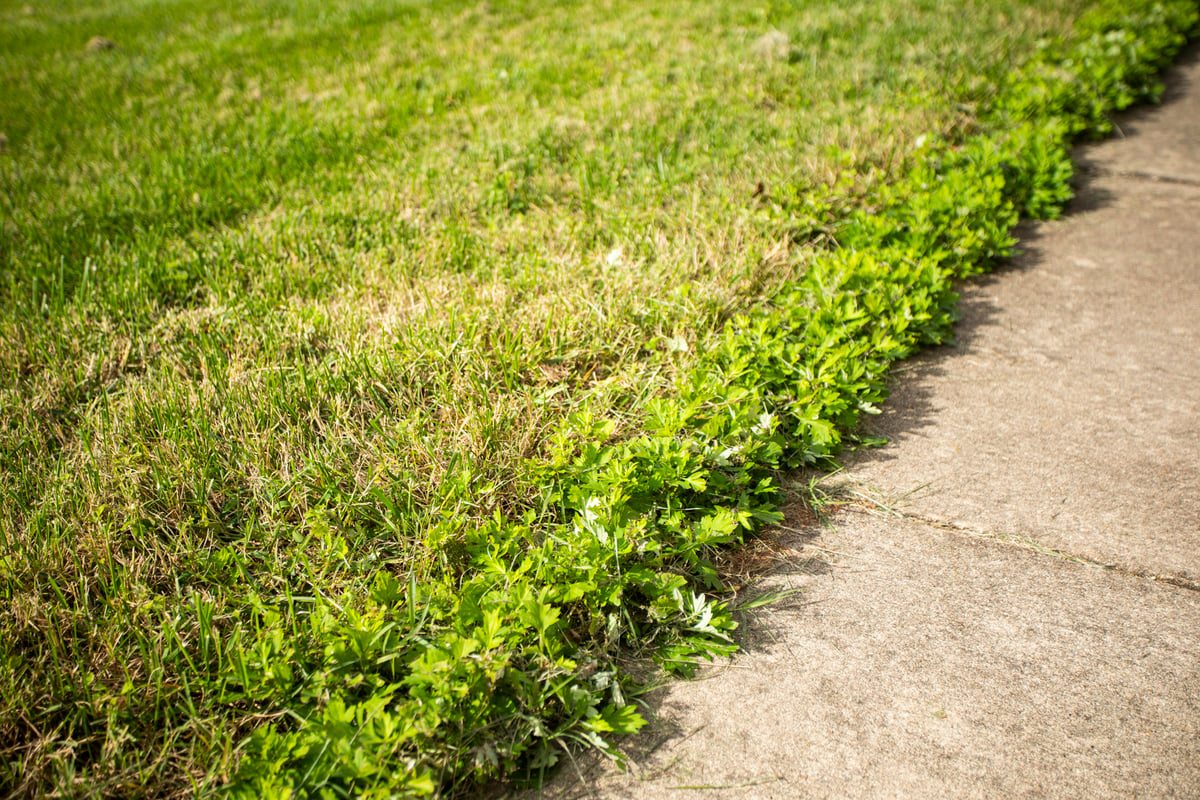 As sod webworms continue growth and feed, the injured areas can enlarge. When large infestations are present, large grass areas can be killed in summer’s heat and drought.
As sod webworms continue growth and feed, the injured areas can enlarge. When large infestations are present, large grass areas can be killed in summer’s heat and drought.
How To Get Rid Of Sod Webworms
A curative insecticide can help you kill sod webworms.
If you fertilize your lawn regularly and receive proper treatments that keep it healthy and thriving, such as aeration and overseeding, your lawn can better withstand lawn insects.
Cutworms
You might see symptoms of dryness in your lawn in summer and think it could be fixed with just some water to get your lush green lawn back.
Unfortunately, if the problem is cutworms in Maryland, your lawn could be in trouble.
Here, we’ll talk about cutworm identification and how to get rid of cutworms in Central and Southern Maryland.
How To Identify Cutworms
Cutworms in Maryland are actually the larvae of a moth, which lays its eggs in clusters in grass during evening hours from spring through fall.
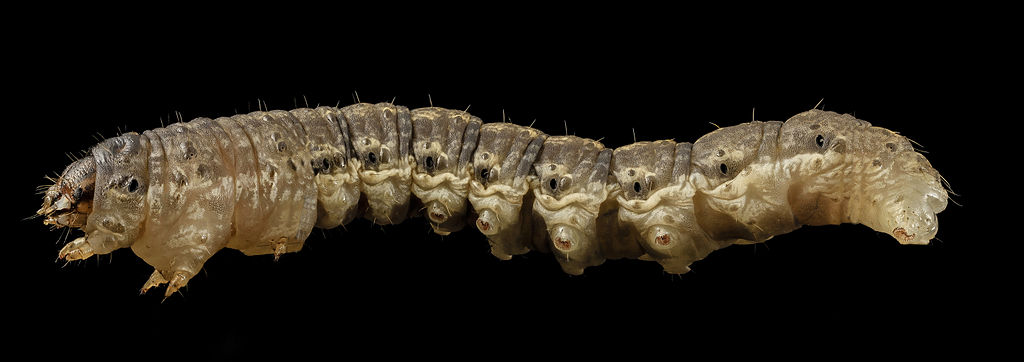 The adult moths are attracted to light, so cutworm invasions often happen on lawns surrounding well-lit homes after eggs hatch.
The adult moths are attracted to light, so cutworm invasions often happen on lawns surrounding well-lit homes after eggs hatch.
Cutworm larvae are 1½ to 2 inches long, with fat brown, gray, or black bodies. They can be striped or spotted.
Signs Of Cutworm Damage
Cutworm larvae hide in the thatch layer of your grass during the day, then come out at night to eat, chewing off grass blades close to the ground. The damage may appear as circular spots of dead grass in spring and early summer.
Cutworms in Maryland can also damage turf when burrowing through the thatch or into the ground.
How To Get Rid Of Cutworms
For cutworm control, a lawn care professional can apply pesticide to the grass stems. It is best to apply the product in the evening before the cutworms come out for feeding.
Cranefly Larvae
As adults, craneflies resemble large mosquitoes. And during this stage of their lives, they are pretty harmless to your grass.
The cranefly larvae, however, thrive in wet lawns, so maintaining proper drainage can help you avoid drawing them in.
Let’s look at what cranefly lawn damage looks like and the best types of cranefly lawn treatments in Maryland.
How To Identify Cranefly Larvae
When cranefly eggs hatch in spring, the larvae look like small, brown worms.
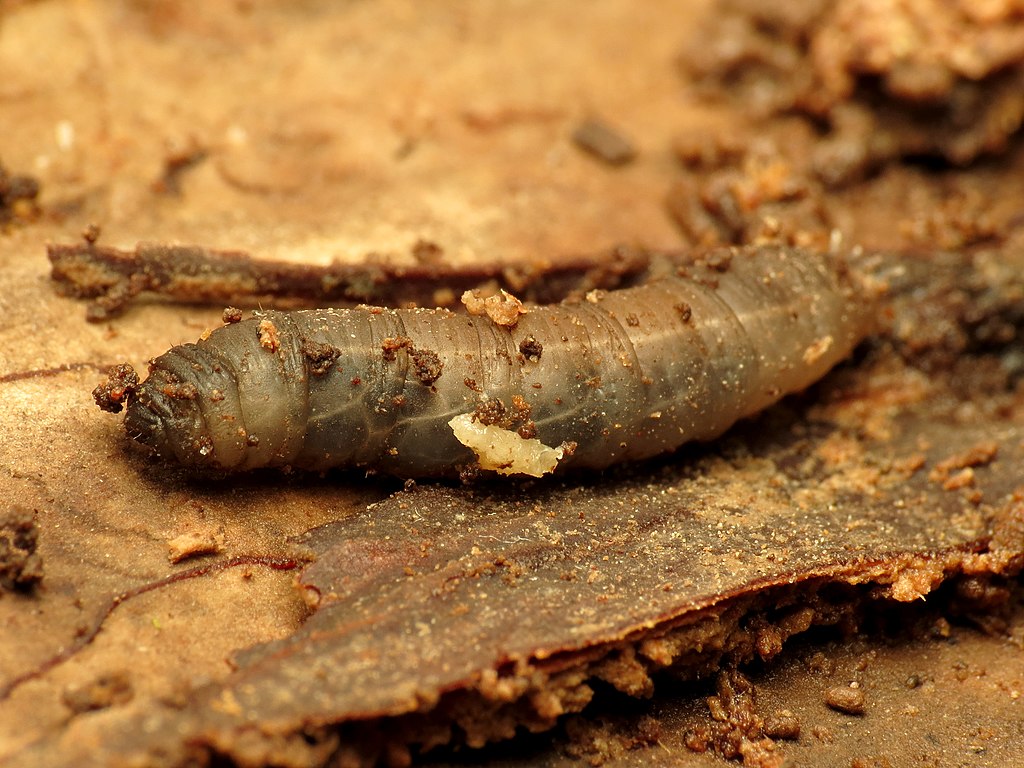 They instantly begin feeding on your grass roots in spring and summer.
They instantly begin feeding on your grass roots in spring and summer.
Signs Of Cranefly Larvae
When cranefly larvae attack your lawn, you may notice yellowing, as well as thin or bare patches throughout your yard.
Additionally, predators like raccoons, birds, and skunks may try and dig up your grass searching for the larvae to eat.
How To Get Rid Of Cranefly Larvae
Catching this lawn pest early is important because their feeding increases as they grow.
Also, since craneflies like wet lawns, avoid overwatering the lawn and make sure that your lawn has adequate drainage. This will discourage adult crane flies from laying their eggs there.
DIY Lawn Pest Control vs. Hiring A Professional
As you learn more about lawn insects in Maryland and try to identify which one is plaguing your lawn, you may also find some information out there about do-it-yourself lawn insect control, as well as professional lawn pest control services.
Let’s look at the differences between these two lawn pest control options so you can make the best choice for you.
DIY Lawn Pest Control Takes Time & Energy
While it may look easy to spread fertilizer on your lawn and spray weeds a couple of times, there’s actually much more to do-it-yourself lawn insect control than that.
First, you need to buy the right products and equipment to get the job done. Your local home improvement store may have quite a few options for you to choose from in both products and equipment, but they won’t carry commercial-grade equipment or treatments. So you may not be getting top-quality products to help your lawn.
 In learning DIY lawn pest control, though, you will be learning a new skill, which is admirable. And that takes some time and effort. Lawn care is a science. Understanding application timing and best practices is essential to doing the job right.
In learning DIY lawn pest control, though, you will be learning a new skill, which is admirable. And that takes some time and effort. Lawn care is a science. Understanding application timing and best practices is essential to doing the job right.
You can also get outside when you try do-it-yourself lawn care, and that fresh air can be great. But you probably also have a day job, so you’ll have to do this work on the weekends when you might prefer to relax.
DIY Lawn Pest Control May Not Save You Money
You may want to invest in do-it-yourself lawn insect control because you think it’ll save you money, but it usually never does.
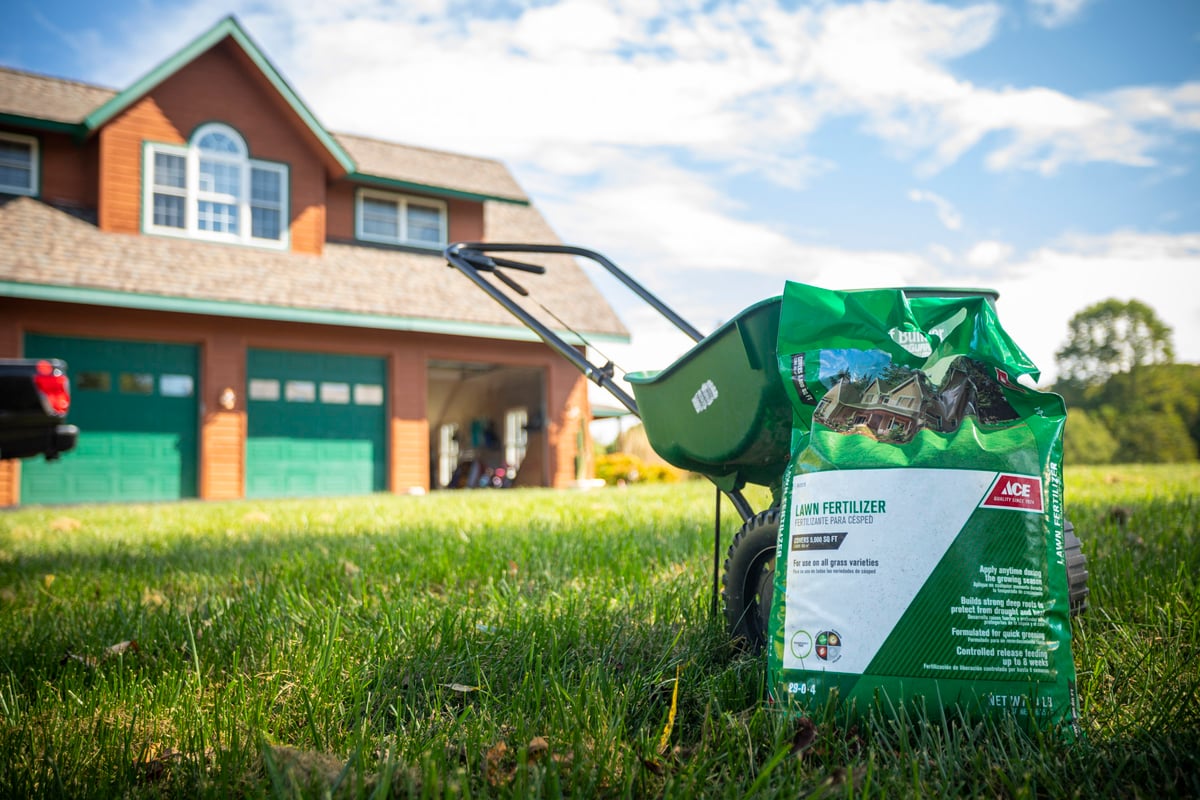 In addition to purchasing products and the right equipment, you also have to correctly store products or else you’ll have to buy fresh treatment products next time you must apply them.
In addition to purchasing products and the right equipment, you also have to correctly store products or else you’ll have to buy fresh treatment products next time you must apply them.
Add to that your time for doing the work on the proper schedule and you may realize that it adds up to quite a bit more than paying for lawn pest control services in Central and Southern Maryland.
Professional Lawn Pest Control Services Can Be More Environmentally Friendly
Hiring a pro to take care of your lawn insect control, can help you protect and preserve the environment a bit better than DIY lawn pest control.
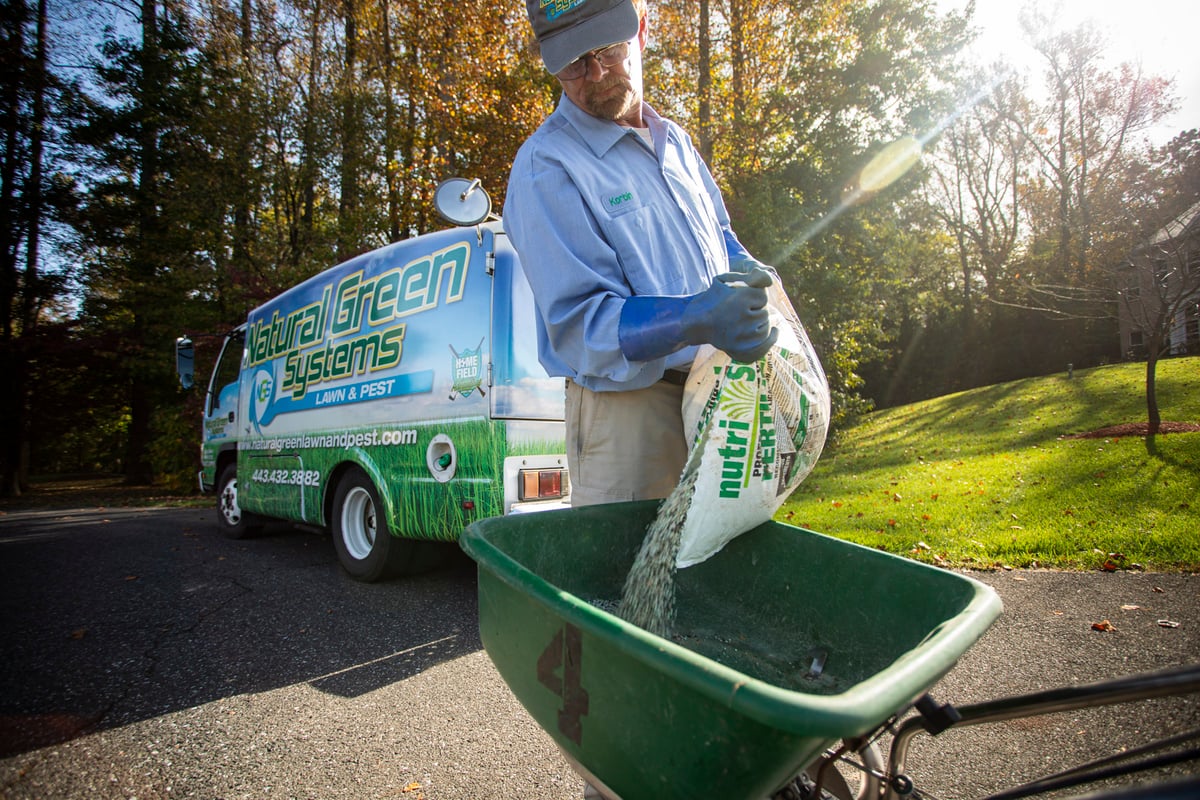 This is because a lawn care professional will do a soil test to determine what your lawn is missing first before coming up with a nutrition program. This ensures you only receive the nutrients you need.
This is because a lawn care professional will do a soil test to determine what your lawn is missing first before coming up with a nutrition program. This ensures you only receive the nutrients you need.
They also have taken training and obtained licensing to learn precise product application techniques. This strategy, by nature, uses less product every visit. Combine this with using commercial-grade products and high-end equipment, and each treatment becomes extremely targeted.
How Much Does Lawn Pest Control Cost?
You may have identified a lawn insect in your lawn and want to know the cost of treatment or you might want to find out if this service is part of a full lawn care package.
As you look at the cost of lawn pest control services, consider these important factors that can impact pricing.
- Hire a company with experienced technicians to ensure solid work. Check reviews to ensure you’re hiring a reputable company. Lower prices might be a red flag, showing you’re hiring less experienced technicians that don’t receive regular training.
- Lawn insect products come in different quality levels. A company that uses more effective, higher quality products may charge a bit more than others. This is something to ask about as you're comparing companies.
- Look for a company that uses a customized approach and offers different levels of service programs to ensure you can find a program that matches your lawn’s needs. This will help you match the right service with the right price.
- Quality control measures ensure precise treatments every time. Make sure the company you hire has measures like this in place to ensure better results.
Doing your research will ensure you receive lawn insect treatments that are worth their price tag and take care of your problem quickly, so you can get that healthy green lawn you love back.
How to Choose Lawn Pest Control Services in Central and Southern Maryland
When you find out lawn insects in Maryland are a problem in your grass, you can feel overwhelmed.
It might be time to bring in some help from a professional to properly identify the pest and treat it quickly so you don’t have to continue watching your lawn deteriorate.
But you might be concerned when you do a Google search and find out there are quite a few companies you can choose from. Which one is right for you?
Here are some things to look at when deciding which company to hire to help you with lawn insect treatments in Central and Southern Maryland.
- Service Solutions - First, make sure you understand exactly what services lawn care providers include in their packages. You want to make sure fertilization, preventive and curative weed control, as well as insect monitoring, are included in your service package. You also want to make sure they offer various insect control solutions. This way, your lawn care technician can spot insects early as they are taking care of your lawn and share their findings with you, so you can choose to take care of the issue before it destroys your lawn.
- Personalized Service is Important - You want your lawn care service provider to conduct a free soil test to get a good idea of what your lawn soil is lacking. This type of attention to detail can ensure you get a more customized lawn care program.
- Don’t Forget To Look At Company Reviews - Company reviews can tell you quite a lot about a business. Make sure to read their reviews – good and bad – and see how responsive they are to negative reviews and what positive reviews have to say about a company’s quality of services and communication skills.
As you’re looking at lawn insect control companies in Central and Southern Maryland, we hope you’ll consider Natural Green Systems in your search. We’d be happy to answer your questions and help you understand what pests may be hurting your lawn and how it can bounce back and become thick, green, and insect-free again.
Ready for a bug-free lawn? Request a free consultation today, and we’ll bring our proven lawn insect control experience to you, creating a custom plan to bring your Central and Southern Maryland lawn back to good health.  View Lawn Care Programs
View Lawn Care Programs
Image Source: grub, armyworm caterpillar, armyworm moth, sod webworm, cutworm, cranefly
You want a nice, green, thick lawn. Who doesn’t?
Unfortunately, lawn insects can get in the way of your plans. They can make your lawn look less than stellar with brown spots, dull color, or even bare areas. And since all of these symptoms can point to other problems, you might actually not even know bugs are the issue.
Let’s look at some common lawn insects in Maryland and how you can eliminate them and keep them out of your grass so your property can shine.
Table of Contents
- How To Identify And Get Rid Of Lawn Pests In Maryland
- Lawn Grubs
- Chinch Bugs
- Armyworms
- Sod Webworms
- Cutworms
- Cranefly Larvae
- DIY Lawn Pest Control Vs. Hiring A Professional
- How Much Does Lawn Pest Control Cost?
- How to Choose Lawn Pest Control Services in Central and Southern Maryland
How To Identify And Get Rid Of Lawn Pests In Maryland
When you sense that your lawn isn’t happy, you may suspect lawn insects. But how do you know which bugs are plaguing your grass and how to get rid of them?
Use This Tool to Compare Your Local Lawn Care Companies
In this guide, we talk about how to identify lawn insects, common signs of damage, and how to get rid of these pests so you can have a great lawn in Maryland.
Lawn Grubs
Grubs in your lawn can be pretty sly. It’s because they work underground, so you may not even see them out right.
In fact, they can attack your lawn and you don’t even know they’re there. Before you realize it, your lawn isn’t doing so well and you’re wondering what went wrong.
Here are the basic facts about grubs in Maryland grasses.
How To Identify Lawn Grubs
So you might have seen an adult grub and not have even realized it. If you’ve seen a Japanese beetle on your rose bushes, for instance, you’ve seen an adult grub.
Lawn grubs are technically the larvae of some insects, such as Japanese Beetles, European Chafers, Southern Masked Chafers, and June Beetles.
 These larvae have C-shaped, white, soft bodies with legs right beneath their brown-ish heads.
These larvae have C-shaped, white, soft bodies with legs right beneath their brown-ish heads.
If you or your lawn care professional suspect a grub infestation, you can sometimes dig up a few small spots in your yard that seem impacted and find these nasty larvae. Other critters, like raccoons and skunks can also be found tearing up a lawn that has grubs since they are treats for these animals.
Signs Of Grub Damage
Since you can’t always see grubs diligently destroying your lawn underground, you want to know the common signs of grubs in your lawn to ensure you catch them before they do too much damage.
 The first symptoms of grub feeding you might notice in your grass are patchy areas of discolored, stressed, or wilting grass. These areas of your lawn may seem like they are suffering from drought, but they don’t respond to watering or irrigation. The areas that look impacted may be irregularly shaped and feel spongy, and if you grab them you might notice they roll right up off the soil as if their roots aren’t even attached to the ground.
The first symptoms of grub feeding you might notice in your grass are patchy areas of discolored, stressed, or wilting grass. These areas of your lawn may seem like they are suffering from drought, but they don’t respond to watering or irrigation. The areas that look impacted may be irregularly shaped and feel spongy, and if you grab them you might notice they roll right up off the soil as if their roots aren’t even attached to the ground.
You may not see symptoms in spring when your grass is vigorously growing. The larvae emerge as flying beetles in summer, feeding on plants above ground and then depositing eggs in lawns again. But it’s likely that you’ll spot the damage once those new grubs hatch and feed on your grass roots that are now weakened by summer’s heat and drought.
How To Get Rid Of Grubs In Your Lawn
The trick to banishing grubs from your grass is catching them when they are young.  Targeting a grub treatment on your lawn by a professional lawn care technician in May and June is the best strategy for preventing severe damage.
Targeting a grub treatment on your lawn by a professional lawn care technician in May and June is the best strategy for preventing severe damage.
Embracing a proactive lawn care program that includes fertilization and weed control can also keep your lawn healthy and help it better withstand lawn grubs.
Chinch Bugs
Pests like chinch bugs in your lawn may be small, but they can do quite a bit of damage to your grass. They basically suck the blades of grass clean with their piercing mouthparts and then inject them with their saliva, clogging the vascular tissues of your lawn and blocking access to water. As a result, your grass tends to suffer and die.
Let’s learn more about these pests and proper chinch bug treatment techniques so you can better battle these insects.
How To Identify Chinch Bugs
Adult chinch bugs in your lawn are pretty small – approximately one-sixth of an inch long – and they have white, shiny wings.
 Since they are so miniscule in size, you may never notice them.
Since they are so miniscule in size, you may never notice them.
Both chinch bug nymphs and adults feed on Maryland lawns. Adults overwinter in thatch or tall grasses to try and stay protected before reemerging in spring to lay their eggs. Within two weeks, females lay up to 170 eggs each on the ground near the base of grass blades or in the blades themselves.
Signs Of Chinch Bug Damage
Chinch bugs in your lawn are so small and fast-moving, so you may not physically see them.
What you may see is the damage they cause. They use their piercing mouths to suck sap from grass blades, giving it a drought-like or stressed appearance. They are most active in July and August. You can find them mostly in Maryland lawns with thick thatch and compaction.
When you first notice small yellowing spots in your lawn, you may assume other issues before realizing it’s chinch bugs, including drought, nutrient deficiencies, or turf disease. As you’re trying to solve those other problems, the chinch bugs may continue harming your lawn.
 If you suspect chinch bugs but can’t really see anything, you can try a test with an open-ended coffee can. Stick it about 2 inches into the soil on the fringe of a patch of damaged grass. Fill it with water, looking for adults as they float to the surface. Add more water as it filters into the soil. In 5 to 10 minutes, you should be able to see some of the bugs. If you don’t have an open-ended coffee can, you can also try removing a core of grass and soil with a shovel and submerging it into a bucket full of water, looking for insects to rise to the top. You may see some nymphs that are orange or red and then adults that are darker with whitish wings.
If you suspect chinch bugs but can’t really see anything, you can try a test with an open-ended coffee can. Stick it about 2 inches into the soil on the fringe of a patch of damaged grass. Fill it with water, looking for adults as they float to the surface. Add more water as it filters into the soil. In 5 to 10 minutes, you should be able to see some of the bugs. If you don’t have an open-ended coffee can, you can also try removing a core of grass and soil with a shovel and submerging it into a bucket full of water, looking for insects to rise to the top. You may see some nymphs that are orange or red and then adults that are darker with whitish wings.
You can also attempt to visually inspect the fringes of the damaged areas where the grass is still green. Pull back the lawn and look for movement of insects beneath the thatch. While chinch bugs can be pretty tough for the untrained eye to spot, it might be worth the effort if you suspect them in your lawn.
How To Get Rid Of Chinch Bugs
When it comes to how to get rid of chinch bugs in Maryland, a lawn care professional will use a curative insecticide application to fight infestations. The treatment will be most effective when the bugs are actively feeding.
Unfortunately, there is no preventive treatment for chinch bugs, but you can help prevent chinch bugs by removing the conditions they love – namely thatch.
 An annual aeration and overseeding service can reduce your thatch and compaction, thicken up your lawn, and improve the health of your soil, encouraging healthier grass. Aeration is the process of using an aerator to pull soil plugs from your lawn to encourage airflow and reduce compaction. Overseeding at this time maximizes seed to soil contact to ensure better germination.
An annual aeration and overseeding service can reduce your thatch and compaction, thicken up your lawn, and improve the health of your soil, encouraging healthier grass. Aeration is the process of using an aerator to pull soil plugs from your lawn to encourage airflow and reduce compaction. Overseeding at this time maximizes seed to soil contact to ensure better germination.
Other preventive methods include taking care of your lawn properly so chinch bugs aren’t drawn in. A stressed lawn attracts chinch bugs. Mow and water your lawn properly, as well as give it regular and precise fertilization treatments.
Armyworms
No one wants bugs chewing up their fine Maryland lawn, and armyworms can definitely use their army-like movement to march across your grass, leaving damage in their wake.
Here, we’ll share a bit more about armyworms in Maryland and how to get rid of armyworms, so you can stay more aware of these turf-invading troops.
How To Identify Armyworms
First, let’s answer the question, “What are armyworms?”
 Armyworm larvae are 1 to 1.5 inches long and dark brownish-green or black with long white, orange, and brown stripes. The adult version of this pest is 1 inch long with a 1.5-inch wingspan, tan color and a small, white spot on each forewing.
Armyworm larvae are 1 to 1.5 inches long and dark brownish-green or black with long white, orange, and brown stripes. The adult version of this pest is 1 inch long with a 1.5-inch wingspan, tan color and a small, white spot on each forewing.
Signs Of Armyworm Damage
Armyworms in Maryland lay eggs on flat tree or shrub leaves. They show up in your grass by using air currents to move. Then they drop and settle in grass, laying egg masses.
 Once they hatch, armyworms feed on your grass, making it look drought-stressed. You can see the difference between drought and armyworm damage if you see ragged holes on your grass blades when you look closely.
Once they hatch, armyworms feed on your grass, making it look drought-stressed. You can see the difference between drought and armyworm damage if you see ragged holes on your grass blades when you look closely.
You might also notice armyworms’ sticky-looking egg masses that will be on plants or even buildings, patios, and outdoor furniture.
How To Get Rid Of Armyworms
What kills armyworms? You can control armyworms with an insecticide treatment.
 Since armyworms can have multiple generations per year, a lawn care professional might recommend a flea and tick control program that includes 4 to 6 applications between April and November that helps keep armyworms away.
Since armyworms can have multiple generations per year, a lawn care professional might recommend a flea and tick control program that includes 4 to 6 applications between April and November that helps keep armyworms away.
Sod Webworms
You might think by late summer, you don’t have much work left to do on your lawn.
Technically, that’s not the case. Some pests like sod webworms can strike in late summer and create some serious stress in your lawn’s life.
That’s why we’re here to help. Let’s look at sod webworm damage and common solutions and treatments for sod webworms in Maryland so you can discover an insect problem before it gets out of control.
How To Identify Sod Webworms
Adult sod webworms are tan-colored moths that are ½ to ¾ of an inch long. But they are pretty harmless. It’s their larvae you have to worry about. These grayish-tan caterpillars have small, dark spots on their bodies and brown heads. They can range from ¾ of an inch to 1 inch in size.
 Adult sod webworms scatter their eggs in the grass in the evenings when flying just above the turf surface in mid-June. Eggs hatch in approximately 10 days, and the larvae begin feeding on your lawn stems and roots until mid to late summer. They tend to feed at night and then hide during daylight hours in burrows lined with silk webbing.
Adult sod webworms scatter their eggs in the grass in the evenings when flying just above the turf surface in mid-June. Eggs hatch in approximately 10 days, and the larvae begin feeding on your lawn stems and roots until mid to late summer. They tend to feed at night and then hide during daylight hours in burrows lined with silk webbing.
Signs Of Sod Webworm Damage
The first signs of a sod webworm infestation are small, ragged brown spots in the turf. Upon closer inspection, these areas will have a grazed or scalped appearance.
 As sod webworms continue growth and feed, the injured areas can enlarge. When large infestations are present, large grass areas can be killed in summer’s heat and drought.
As sod webworms continue growth and feed, the injured areas can enlarge. When large infestations are present, large grass areas can be killed in summer’s heat and drought.
How To Get Rid Of Sod Webworms
A curative insecticide can help you kill sod webworms.
If you fertilize your lawn regularly and receive proper treatments that keep it healthy and thriving, such as aeration and overseeding, your lawn can better withstand lawn insects.
Cutworms
You might see symptoms of dryness in your lawn in summer and think it could be fixed with just some water to get your lush green lawn back.
Unfortunately, if the problem is cutworms in Maryland, your lawn could be in trouble.
Here, we’ll talk about cutworm identification and how to get rid of cutworms in Central and Southern Maryland.
How To Identify Cutworms
Cutworms in Maryland are actually the larvae of a moth, which lays its eggs in clusters in grass during evening hours from spring through fall.
 The adult moths are attracted to light, so cutworm invasions often happen on lawns surrounding well-lit homes after eggs hatch.
The adult moths are attracted to light, so cutworm invasions often happen on lawns surrounding well-lit homes after eggs hatch.
Cutworm larvae are 1½ to 2 inches long, with fat brown, gray, or black bodies. They can be striped or spotted.
Signs Of Cutworm Damage
Cutworm larvae hide in the thatch layer of your grass during the day, then come out at night to eat, chewing off grass blades close to the ground. The damage may appear as circular spots of dead grass in spring and early summer.
Cutworms in Maryland can also damage turf when burrowing through the thatch or into the ground.
How To Get Rid Of Cutworms
For cutworm control, a lawn care professional can apply pesticide to the grass stems. It is best to apply the product in the evening before the cutworms come out for feeding.
Cranefly Larvae
As adults, craneflies resemble large mosquitoes. And during this stage of their lives, they are pretty harmless to your grass.
The cranefly larvae, however, thrive in wet lawns, so maintaining proper drainage can help you avoid drawing them in.
Let’s look at what cranefly lawn damage looks like and the best types of cranefly lawn treatments in Maryland.
How To Identify Cranefly Larvae
When cranefly eggs hatch in spring, the larvae look like small, brown worms.
 They instantly begin feeding on your grass roots in spring and summer.
They instantly begin feeding on your grass roots in spring and summer.
Signs Of Cranefly Larvae
When cranefly larvae attack your lawn, you may notice yellowing, as well as thin or bare patches throughout your yard.
Additionally, predators like raccoons, birds, and skunks may try and dig up your grass searching for the larvae to eat.
How To Get Rid Of Cranefly Larvae
Catching this lawn pest early is important because their feeding increases as they grow.
Also, since craneflies like wet lawns, avoid overwatering the lawn and make sure that your lawn has adequate drainage. This will discourage adult crane flies from laying their eggs there.
DIY Lawn Pest Control vs. Hiring A Professional
As you learn more about lawn insects in Maryland and try to identify which one is plaguing your lawn, you may also find some information out there about do-it-yourself lawn insect control, as well as professional lawn pest control services.
Let’s look at the differences between these two lawn pest control options so you can make the best choice for you.
DIY Lawn Pest Control Takes Time & Energy
While it may look easy to spread fertilizer on your lawn and spray weeds a couple of times, there’s actually much more to do-it-yourself lawn insect control than that.
First, you need to buy the right products and equipment to get the job done. Your local home improvement store may have quite a few options for you to choose from in both products and equipment, but they won’t carry commercial-grade equipment or treatments. So you may not be getting top-quality products to help your lawn.
 In learning DIY lawn pest control, though, you will be learning a new skill, which is admirable. And that takes some time and effort. Lawn care is a science. Understanding application timing and best practices is essential to doing the job right.
In learning DIY lawn pest control, though, you will be learning a new skill, which is admirable. And that takes some time and effort. Lawn care is a science. Understanding application timing and best practices is essential to doing the job right.
You can also get outside when you try do-it-yourself lawn care, and that fresh air can be great. But you probably also have a day job, so you’ll have to do this work on the weekends when you might prefer to relax.
DIY Lawn Pest Control May Not Save You Money
You may want to invest in do-it-yourself lawn insect control because you think it’ll save you money, but it usually never does.
 In addition to purchasing products and the right equipment, you also have to correctly store products or else you’ll have to buy fresh treatment products next time you must apply them.
In addition to purchasing products and the right equipment, you also have to correctly store products or else you’ll have to buy fresh treatment products next time you must apply them.
Add to that your time for doing the work on the proper schedule and you may realize that it adds up to quite a bit more than paying for lawn pest control services in Central and Southern Maryland.
Professional Lawn Pest Control Services Can Be More Environmentally Friendly
Hiring a pro to take care of your lawn insect control, can help you protect and preserve the environment a bit better than DIY lawn pest control.
 This is because a lawn care professional will do a soil test to determine what your lawn is missing first before coming up with a nutrition program. This ensures you only receive the nutrients you need.
This is because a lawn care professional will do a soil test to determine what your lawn is missing first before coming up with a nutrition program. This ensures you only receive the nutrients you need.
They also have taken training and obtained licensing to learn precise product application techniques. This strategy, by nature, uses less product every visit. Combine this with using commercial-grade products and high-end equipment, and each treatment becomes extremely targeted.
How Much Does Lawn Pest Control Cost?
You may have identified a lawn insect in your lawn and want to know the cost of treatment or you might want to find out if this service is part of a full lawn care package.
As you look at the cost of lawn pest control services, consider these important factors that can impact pricing.
- Hire a company with experienced technicians to ensure solid work. Check reviews to ensure you’re hiring a reputable company. Lower prices might be a red flag, showing you’re hiring less experienced technicians that don’t receive regular training.
- Lawn insect products come in different quality levels. A company that uses more effective, higher quality products may charge a bit more than others. This is something to ask about as you're comparing companies.
- Look for a company that uses a customized approach and offers different levels of service programs to ensure you can find a program that matches your lawn’s needs. This will help you match the right service with the right price.
- Quality control measures ensure precise treatments every time. Make sure the company you hire has measures like this in place to ensure better results.
Doing your research will ensure you receive lawn insect treatments that are worth their price tag and take care of your problem quickly, so you can get that healthy green lawn you love back.
How to Choose Lawn Pest Control Services in Central and Southern Maryland
When you find out lawn insects in Maryland are a problem in your grass, you can feel overwhelmed.
It might be time to bring in some help from a professional to properly identify the pest and treat it quickly so you don’t have to continue watching your lawn deteriorate.
But you might be concerned when you do a Google search and find out there are quite a few companies you can choose from. Which one is right for you?
Here are some things to look at when deciding which company to hire to help you with lawn insect treatments in Central and Southern Maryland.
- Service Solutions - First, make sure you understand exactly what services lawn care providers include in their packages. You want to make sure fertilization, preventive and curative weed control, as well as insect monitoring, are included in your service package. You also want to make sure they offer various insect control solutions. This way, your lawn care technician can spot insects early as they are taking care of your lawn and share their findings with you, so you can choose to take care of the issue before it destroys your lawn.
- Personalized Service is Important - You want your lawn care service provider to conduct a free soil test to get a good idea of what your lawn soil is lacking. This type of attention to detail can ensure you get a more customized lawn care program.
- Don’t Forget To Look At Company Reviews - Company reviews can tell you quite a lot about a business. Make sure to read their reviews – good and bad – and see how responsive they are to negative reviews and what positive reviews have to say about a company’s quality of services and communication skills.
As you’re looking at lawn insect control companies in Central and Southern Maryland, we hope you’ll consider Natural Green Systems in your search. We’d be happy to answer your questions and help you understand what pests may be hurting your lawn and how it can bounce back and become thick, green, and insect-free again.
Ready for a bug-free lawn? Request a free consultation today, and we’ll bring our proven lawn insect control experience to you, creating a custom plan to bring your Central and Southern Maryland lawn back to good health.  View Lawn Care Programs
View Lawn Care Programs
Image Source: grub, armyworm caterpillar, armyworm moth, sod webworm, cutworm, cranefly
Share This
Topics: Pest Control, Lawn Care, Guide

